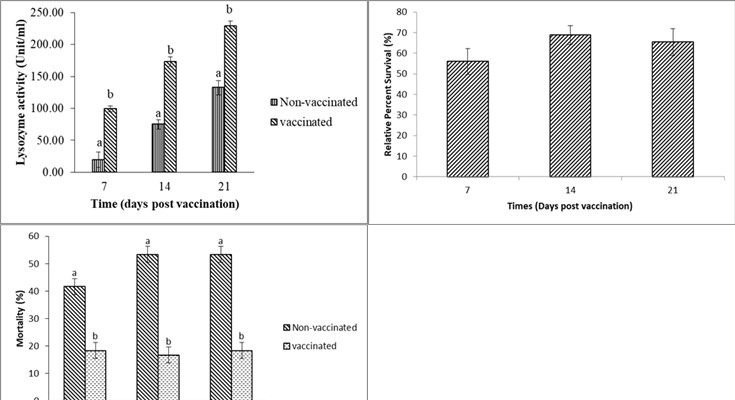Akuatikisle: Jurnal Akuakultur, Pesisir dan Pulau-Pulau Kecil
Full Length Article
Efficacy of attenuated bacteria vaccine against streptococcal infection in larvae tilapia (Oreochromis niloticus)
Highlights
Generate NLP AI by Wizdam ID.
Abstract
One of the common diseases found in tilapia is a streptococcal disease caused by the Streptococcus agalactiae bacteria. Treatment of this disease is generally done by using antibiotics. The use of antibiotics in controlling disease in fish can create resistant bacterial strains with certain doses. The use of vaccines is one of the alternative control methods in fish defence against infections. The purpose of this study was to analyze the efficacy of vaccination on seeds through immersion using attenuated active bacteria to increase immunity at the beginning of the spread of streptococcosis disease. The vaccine used was obtained from attenuated Streptococcus agalactiae bacteria through repeated passage ten times. Vaccination was carried out through oral vaccine. Challenge tests were carried out on days 7, 14, and 21 days after vaccination on tilapia larvae by immersion. The result indicated that vaccination using attenuated bacteria could increase lysozyme activity at each observation time compared to control. The mortality of post-challenged larvae on days 7, 14 and 21 post-vaccination was lower than that of unvaccinated seed. The percentage of RPS values up to the 14th day of observation has increased and tends to decrease on the 21st day.
Keywords
Introduction
Section snippets
Material and Methods
Materials and methods from the full-text PDF of this article cannot be displayed.
Results
Results from the full-text PDF of this article cannot be displayed.
Discussion
Discussion from the full-text PDF of this article cannot be displayed.
Conclusions
Conclusions from the full-text PDF of this article cannot be displayed.
Acknowledgment
Acknowledgment from the full-text PDF of this article cannot be displayed.
Funding Information
Indonesian Ministry of Research, Technology and Higher Education (Ristekdikti) to provide funding for this study (contract no. 6572/LL9/ KU.03.00/2021).
Competing interest
The authors declare that they have no known competing financial interests or personal relationships that could have appeared to influence the work reported in this paper.
Conflict of interest
The authors declare that the research was conducted in the absence of any commercial or financial relationships that could be construed as a potential conflict of interest.
Ethical approval acknowledgements
No ethical approval required for this article. All procedures followed were in accordance with the ethical standards of the responsible committee on human experimentation (institutional and national) and with the Helsinki Declaration of 1975, as revised in 2008 (5)
Supplementary files
Data sharing not applicable to this article as no datasets were generated or analysed during the current study, and/or contains supplementary material, which is available to authorized users.
References (1)
Akbary P, Mirvaghefi AR, Akhlaghi M, Amiri BM, Fereidouni MS. 2015. The effects of letrozole in transfer of maternal immunity against lactococcosis to eggs and larvae in rainbow trout (Oncorhynchus mykiss, Walbaum). Food and Nutrition Sciences, 6: 254-264. https://doi.org/10.4236/fns.2015.62026
Amend DF. 1981. Potency testing of fish vaccines. Dev Biol Stand 49:447–454
Anshary H, Kurniawan RA, Sriwulan S, Ramli R, and Baxa DV. 2014. Isolation and molecular identification of the etiological agents of Streptococcosis in Nile tilapia (Oreochromis niloticus) cultured in net cages in Lake Sentani, Papua, Indonesia. Springerplus 3: 627. https://doi.org/10.1186/2193-1801-3-627
Chen WH, Garza J, Choquette M, Hawkins J, Hoeper A, Bernstein DI, Cohen MB. 2015. Safety and immunogenicity of escalating dosages of a single oral administration of peru-15 pCTB, a candidate live, attenuated vaccine against enterotoxigenic Escherichia coli and Vibrio cholerae. Clinical and Vaccine Immunology, 22:129-35. https://doi.org/10.1128/CVI.00560-14.
Hanif A., Bakopoulos V., Dimitriadis G.J. 2004. Maternal transfer of humoral specific and non-specific immune parameters to sea bream (Sparus aurata) larvae. Fish and Shellfish Immunology 17 : 411-435. https://doi.org/10.1016/j.fsi.2004.04.013
Hanif A, Bakopoulos V, Dimitriadis GJ. 2005. The effect of sea bream Sparus aurata broodstock and larval vaccination on the susceptibility by Photobacterium damsela subsp. piscicida and on the humoral immune parameters. Fish and Shellfish Immunology 19: 345- 361. https://doi.org/10.1016/j.fsi.2004.12.009
Li, L.P., Wang, R., Liang, W.W., Huang, T., Huang, Y., Luo, F.G., Lei, A.Y., Chen, M., Gan, X. 2015. Development of live attenuated Streptococcus agalactiae vaccine for tilapia via continuous passage in vitro. Fish Shellfish Immunol. 45, 955–963. https://doi.org/10.1016/j.fsi.2015.06.014
Lusiastuti AM, Gardenia L, Mufidah T, and Aryati Y. 2009. First report of Streptococcus agalactiae of tilapia (Oreochromis niloticus) from Cirata reservoir of West Java. Indonesian Aquaculture Journal 4: 47–51. http://doi.org/10.15578/iaj.4.1.2009.47-51
Lusiastuti AM, Textor M, Seeger H, Akineden Ö, Zschöck M. 2014. Short Communication : The Occurrence Of Streptococcus agalactiae Sequence Type 261 From Fish Disease Outbreaks of Tilapia Oreochromis niloticus in Indonesia. Aquaculture Research 45: 1260–1263. https://doi.org/10.1111/are.12069
Makesh M, Sudheesh PS, Cain KD. 2015. Systemic and mucosal immune response of rainbow trout to immunization with an attenuated Flavobacterium psychrophilum vaccine strain by different routes. Fish Shellfish Immunol, 44:156-63. https://doi.org/10.1016/j.fsi.2015.02.003.
Mohd-Aris, A., Muhamad-Sofie, M.H.N., Zamri-Saad, M., Daud, H.M., Ina-Salwany, M.Y. 2019. Live vaccines against bacterial fish diseases: A review, Veterinary World, 12(11): 1806- 1815. https://dx.doi.org/10.14202%2Fvetworld.2019.1806-1815
Nisaa K, Sukenda, Junior MZ, Lusiastuti AM, Nuryati S. 2016. Resistance of tilapia Oreochrimis niloticus fry vaccinated at different gonadal developmental stages toward Streptococcus agalactiae infection. Jurnal Veteriner 3: 355–364. https://doi.org/10.19087/jveteriner.2016.17.3.355
Nermen, M., Abu-Elala, Samir, A., Wasfy, M., Elsayed, M. 2019. Efficacy of Injectable and Immersion Polyvalent Vaccine against Streptococcal Infections in Broodstock and Offspring of Nile tilapia (Oreochromis niloticus). Fish and Shellfish Immunology, 88: 293-300. https://doi.org/10.1016/j.fsi.2019.02.042
Sukenda S, Rahman R, Nisaa K, Vinasyiam A, Hidayatullah D. 2018. The efficacy of Streptococcus agalactiae vaccine preparations, administered to tilapia broodstock, in preventing streptococcosis in their offspring, via transfer of maternal immunity. Aquaculture International, 26:785-798
Taukhid, Purwaningsih, U., dan Lusiastuti, A.M. 2012. Pengembangan Vaksin in-aktif Bakteri Streptococcus agalactiae : Penentuan Teknik Aplikasi dan Dosis Efektif Vaksin Melalui Perendaman untuk Pencegahan Penyakit Streptococcosis pada Ikan Nila, Oreochromis niloticus. Prosiding Seminar Hasil Penelitian Terbaik Tahun 2012. Badan Penelitian dan Pengembangan Kelautan dan Perikanan. pp 17 – 28.
Bibliographic Information
Cite this article as:
-
Submitted
10 November 2021 -
Accepted
14 November 2021 -
Published
15 November 2021 -
Version of record
26 November 2021 -
Issue date
30 November 2021
-
Academic subject
Aquaculture
Copyright
Sangia Advertisement
The Indonesian Archipelago has enormous potential for marine resources. Marine biological resources are scattered in almost all areas from the coast to the deep sea. Various biological resources of mangroves, fish, shellfish, crustaceans, corals, and much more. Behind that, there are the challenges of resource management and economic growth.
Copyright © 2021 Agus Suryahman, Andi Masriah, Khairun Nisaa, Rahmi, Akmal. Sangia Research Media and Publishing. Production and hosting by Sangia (SRM™).  This work is licensed under a Creative Commons Attribution-ShareAlike 4.0 International License.
This work is licensed under a Creative Commons Attribution-ShareAlike 4.0 International License.
Disclaimer: All claims expressed in this article are solely those of the authors and do not necessarily represent those of their affiliated organizations, or those of the publisher, the editors and the reviewers. Any product that may be evaluated in this article or claim that may be made by its manufacturer is not guaranteed or endorsed by the publisher.
Comments on this article
By submitting a comment you agree to abide by our Terms and Community Guidelines. If you find something abusive or that does not comply with our terms or guidelines please flag it as inappropriate.









